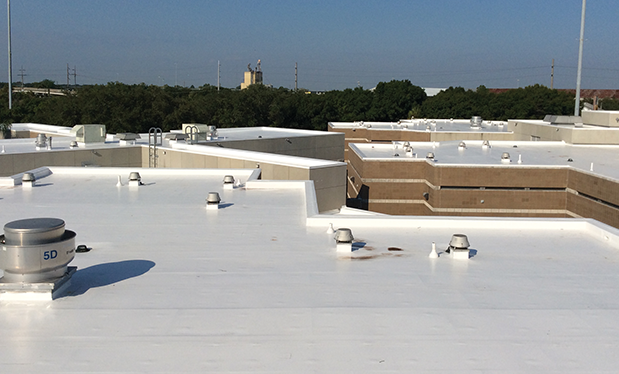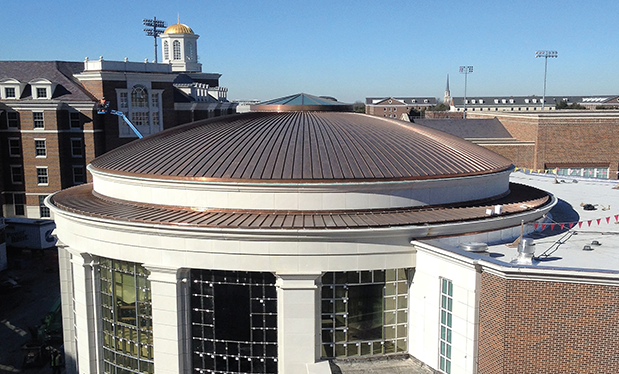In September, NRCA published Quality Control and Quality-assurance Guidelines for the Application of Membrane Roof Systems. This new publication provides NRCA's latest best practice guidelines for assessing the application of built-up, polymer-modified bitumen, EPDM and thermoplastic membrane roof systems.
QC and QA
Quality control (QC) and quality assurance (QA) are essential elements of roof membrane construction. However, the parties that implement these two concepts differ.
QC is the responsibility of and is performed by roofing contractors. It is a contractor's responsibility to designate an individual to be on-site during the entire application process; that individual may be a working member of the crew, such as a foreman. This person should thoroughly understand the membrane roof system being installed and have the authority to immediately correct noncompliant work.
QA, when performed, is the responsibility of the building owner; a designated representative (such as a design professional, general contractor or construction manager, or roof consultant); or a roof system manufacturer representative. The person performing QA must understand the roof system being installed and its application methods. A QA person must inform the roofing contractor immediately if he or she observes noncompliant work so necessary corrective actions can be taken. Written documentation should follow every QA visit. A copy of daily reports should be distributed to the roofing contractor no later than the commencement of work the next day. If the QA person does not immediately notify the roofing contractor of noncompliant work or does not produce written reports in a timely manner, he or she is not providing effective QA.
NRCA contends the most effective way to perform QC and QA for membrane roof system application is to evaluate the quality of the application at the time of application. This approach not only allows for assessment of the application of roof system components that are subsequently concealed by additional application operations, but it also best facilitates prompt correction of any noncompliant work.
Assessment and corrective action
The publication also provides NRCA-recommended assessment criteria and corrective actions. Each roof system type covered by the document is addressed by an individual chapter. Chapter 1 addresses built-up membrane roof systems; Chapter 2 addresses polymer-modified bitumen membrane roof systems; Chapter 3 addresses EPDM membrane roof systems and Chapter 4 addresses thermoplastic membrane roof systems.
In Chapter 4, for example, assessment criteria and, if necessary, any corrective action are provided for the application of roof decks; vapor and air retarders; insulation; fasteners; adhesives, primers and conditioners; membranes; membrane flashings; and architectural metal flashings for thermoplastic membrane roof systems.
At the end of each chapter, a checklist is provided specific to the roof system type for assessing key application parameters affecting roof system application.
Test cuts
Test cuts are not considered to be a part of a routine QC or QA program. Test cuts should not be substituted for in-process QC or QA provided by continuous visual examination.
However, test cuts may assist in the evaluation of the extent or magnitude of problems observed during routine QC or QA. An appendix at the end of each chapter provides test cut guidance specific to the roof system type being addressed.
Field uplift testing
Similarly, field uplift tests are not considered to be a part of a routine QC or QA program and should not be substituted for in-process QC or QA.
Experience has shown the results from field uplift testing are inconsistent and highly variable; NRCA does not recommend you rely upon them. Also, small test areas (or test cuts) likely do not accurately represent the overall membrane application over large roof system areas.
An appendix at the end of each chapter provides a discussion of field uplift testing specific to the roof system type being addressed.
Use it
If you are involved with the application of membrane roof systems, I encourage you to use NRCA's new guidelines. When used with a roof system manufacturer's installation instructions, NRCA's guidelines can be invaluable for defining the attributes of a quality membrane roof system installation.
The electronic version of the guidelines is free to NRCA members via the NRCA app or by visiting shop.nrca.net. Nonmembers can purchase the publication at shop.nrca.net.
Mark S. Graham is NRCA's vice president of technical services.
@MarkGrahamNRCA



